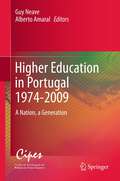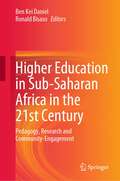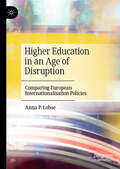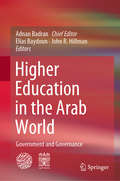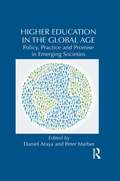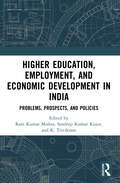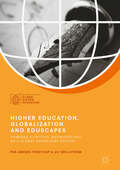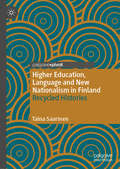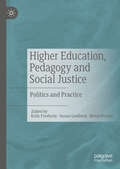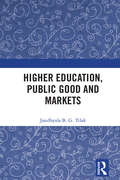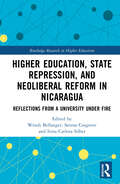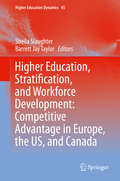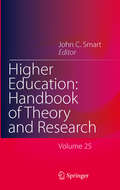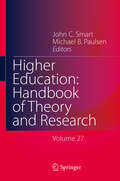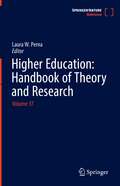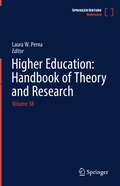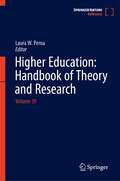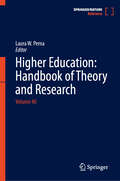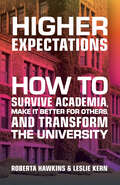- Table View
- List View
Higher Education in Market-Oriented Socialist Vietnam: New Players, Discourses, and Practices (International and Development Education)
by Phan Le Ha Doan Ba NgocThis book inspects higher education reform in market-oriented socialist Vietnam, with a focus on newness narratives and enquiry. Engaging in dialogic conversations with global and regional forces and exploring convergences in the domains of policy, curriculum, research, pedagogy, and society, chapter authors analyse ideologies that have entered Vietnam’s educational landscape. Chapters include discussions of post-Soviet legacies, socialist thought, privatization, neoliberalism, global rankings, academic freedom, autonomy, and elitism, as well as the actors, discourses and practices through which they manifest. In so doing, authors’ commentaries juxtapose phenomena in Vietnam with other national contexts such as the Philippines, Brunei Darussalam, Japan, Australia, and Trinidad and Tobago.
Higher Education in Portugal 1974-2009
by Guy Neave Alberto AmaralA comprehensive, wide ranging and detailed account of the unfolding of higher education and higher education policy in Portugal from 1974 to 2009 by leading policy-makers and scholars, with the explicit purpose of showing how different disciplinary canons and perspectives contribute to the study of higher education and higher education policy including Law and Science Policy perspectives. Whilst focusing on one referential system, this book deals with current policy issues emerging in the wake of the post Bologna period. It also examines their long term historical origins in addition to the measures taken to address them. The substantive chapters are preceded by a detailed Introductory overview that places the issues treated in this volume in a solidly European perspective and sets out explicitly the differences in the dominant political, cultural and social values that set Portuguese as other Continental European systems of higher education apart from their Anglo Saxon counterparts.
Higher Education in Romania: Overcoming Challenges and Embracing Opportunities
by Adrian Curaj Jamil Salmi Cezar Mihai HâjThis open access book includes a series of relevant policy research articles, elaborared in the framework of the “Quality in higher education: internationalisation and databases to enhance the Romanian education system” project, implemented by the Executive Agency for Higher Education, Research, Development and Innovation Funding (UEFISCDI), together with the Ministry of Education. The project aims to develop and implement systemic measures at tertiary education level, leading to an increased quality of the overall higher education system and universities better prepared for labour market requirements and international standards. The book focuses on areas of interest for Romanian higher education, such as systemic measures to improve access, participation and completion for (vulnerable) students, better promotion of the Romanian higher education to attract students, as well as instruments for a more efficient use of data at higher education level. Each article includes evidence-based policy proposals that could support new strategic initiatives in higher education, including new legislation. Additionally, the collection of articles tells a comprehensive story about the audacity of a higher education system which went through significant challenges to align itself with both European and international trends, as well as respond to national imperatives.Over the last three decades, since the fall of the Iron Curtain, Romanian higher education has undergone significant transformations, aiming to align itself to the latest developments and trends at European and international level. The National Law on Education no. 1/2011 has set the stage for a full implementation of the Bologna Process action lines, taking into account that Romania was already a part of the largest European intergovernmental process – currently the European Higher Education Area (EHEA) – as a founding member.However, since the adoption of this normative framework, the law suffered numerous amendments, making it challenging to observe and achieve coherence in its implementation. Furthermore, Romania is also currently redesigning the strategy for the alocation of European structural funds 2021-2027, based on two strategic documents - the new Education and Employment Operational Programme and the National Recovery and Resilience Plan which highlight the reform and investment priorities at a national level.At the same time, 2021 is a good time to analyze the level of implementation for the objectives and measures included in the National Strategy for Tertiary Education 2015-2020, the Europe 2020 Strategy, and the Bologna Process action lines in the 2010 – 2020 timeframe. Therefore, the present moment may be an important time to assess the impact of strategic documents and actions in the last decade and, possibly, to draft a new National Education Law, better adapted to current realities, starting from the recent initiative by the President of Romania – the Educated Romania strategic vision which was also politically assumed by the Romanian Government.
Higher Education in Saudi Arabia
by Larry Smith Abdulrahman AbouammohThis book provides the first academically rigorous description and critical analysis of the Higher Education system in the Kingdom of Saudi Arabia, and of the vision, strategies and policy imperatives for the future development of Saudi universities. The government of Saudi Arabia has recognized in both policy and practice the necessity of developing its university system to world-class standard. Significantly increasing access and participation in Higher Education across a range of traditional and non-traditional disciplines is directly relevant to the future social and economic growth of the country. This book addresses the way in which Saudi Arabia is moving to develop a quality university system that balances the need for students to gain the knowledge, skills and 'ways of doing' necessary to operate effectively on the world stage while simultaneously maintaining and demonstrating the fundamental values of the Islamic religion and culture. The book provides a description and critical analysis of the key components of the Saudi Higher Education system, and of system-level responses to the challenges and opportunities facing Saudi universities. It is written by a team of Saudi academics and authors of international standing from non-Saudi universities so as to provide both internal and external perspectives on all issues and to place information and ideas in the context of the international Higher Education scene.
Higher Education in Sub-Saharan Africa in the 21st Century: Pedagogy, Research and Community-Engagement
by Ben Kei Daniel Ronald BisasoThis book contributes to the understanding of regional and global perspectives on the development and challenges the higher education sector in sub-Saharan Africa faces in the era of globalization. It focuses on the critical aspects of the higher education sector in the Global South, with a particular emphasis on sub-Saharan Africa. It brings together empirical, theoretical and philosophical perspectives from researchers in some of the leading universities in sub-Saharan Africa. The book highlights the higher education sector’s stages of growth and development and the contemporary challenges it faces in aligning its goals and capacity globally, and maintaining its image and public identity locally. This book covers neoliberal educational reforms, leadership and governance, pedagogy, technology, the global knowledge economy, and digital advancement. It delves into how the nature and practice of learning, teaching, research, and community engagement as core functions of higher education are re-oriented to contribute to societal transformation in Africa. Further, the book discusses the implications of contemporary issues in higher education: internationalization, employability, leadership and management, and accountability and autonomy in teaching, research, and community engagement.
Higher Education in Taiwan: Global, Political and Social Challenges and Future Trends (Higher Education in Asia: Quality, Excellence and Governance)
by Sheng-Ju Chan Angela Yung-Chi Hou Tung-Liang ChiangThis book discusses the situation of Taiwanese universities facing a rapidly changing domestic and global environment. It examines the social structure, drawing on professional perspectives, data-based and systematic analysis. The book fills gaps in the literature of higher education systems in East Asia, of which Taiwan is a representative nation. It provides the readers with great opportunities to understand the historical, political and cultural background of the higher education system in Taiwan and shares Taiwan’s experience of how higher education institutions respond to the new challenges such as an ageing society, the pursuit of equity and inclusion, execution of talent recruitment, and the use of technological innovation. Finally the book discusses the implication of institutional research in university governance.
Higher Education in Vietnam
by Simon Marginson L� Th? Tr?n Ho�ng Minh � Quy�n Th? Ng?c �? Tr�c Th? Thanh L� Nh�i Th? Nguy?n Th?o Th? Phuong Vu Th?ch Ng?c Ph?m Huong Th? Lan Nguy?n Ti�n Th? H?nh H?Higher and tertiary education have become crucial to modern economies and societies. As a nation, Vietnam has great potential and its secondary school students perform very well in comparative international tests, yet its universities and colleges are poor-performing, under-funded and slow to change compared to those in neighbouring East Asian nations like China and South Korea. Why is this the case - and what can be done about it? Higher Education in Vietnam dissects the problems and provides constructive and well-located solutions, combining reform with Vietnam's strong educational tradition, for the transformation of higher education in governance, funding, curriculum, quality assurance, internationalization, language policy, research and vocational training. Written by a team of expert insiders with international experience, this book is the first comprehensive diagnosis and prescription for higher education in Vietnam and establishes a distinctive Vietnamese pathway for modernization in the global knowledge economy.
Higher Education in an Age of Disruption: Comparing European Internationalisation Policies
by Anna P. LohseThis book investigates European higher education internationalisation policies during a period marked by extreme upheaval due to Brexit and the COVID-19 pandemic. Situating her analysis at the intersection of higher education research and policy studies, the author combines historical and sociological institutionalism to investigate how this time of disruption impacted higher education policies in England, France and Germany. Based on extensive qualitative data derived from expert interviews and document analysis, the study offers timely insights into dynamics of institutional change and stability in higher education governance, as well as implications for the future of cross-border education and internationalisation. The book will appeal to academics and students interested in education policy and the internationalisation of higher education.
Higher Education in the Arab World: Government and Governance
by Elias Baydoun John R. Hillman Adnan BadranThis book examines the unsatisfactory situation in the Arab world where there is a pressing need to address poverty, unemployment, political instability, corruption, and the existential threat of climate change. The authors analyze the relationships between universities and governments in the Arab world, and make recommendations that will help develop intellectual capacity and thereby aid the economic and social transitions so desperately needed in all Arab countries. Countries aspiring to participate fully in the global knowledge economy require dynamic university sectors operating in concert with governments that actively promote high-quality education and research and foster innovation and entrepreneurship. Successful university-government relationships can be complex and are continually evolving.
Higher Education in the Global Age: Policy, Practice and Promise in Emerging Societies (Routledge Studies in Emerging Societies #4)
by Peter Marber Daniel ArayaDiscussions on globalization now routinely focus on the economic impact of developing countries in Asia, Africa, the Middle East, the former Soviet Union and Latin America. Only twenty-five years ago, many developing countries were largely closed societies. Today, the growing power of “emerging markets” is reordering the geopolitical landscape. On a purchasing power parity basis, emerging economies now constitute half of the world’s economic activity. Financial markets too are seeing growing integration: Asia now accounts for 1/3 of world stock markets, more than double that of just 15 years ago. Given current trajectories, most economists predict that China and India alone will account for half of global output by 2050 (almost a complete return to their positions prior to the Industrial Revolution). How is higher education shaping and being shaped by these massive tectonic shifts? As education rises as a geopolitical priority, it has converged with discussions on economic policy and a global labor market. As part of the Routledge Studies in Emerging Societies series, this edited collection focuses on the globalization of higher education, particularly the increasing symbiosis between advanced and developing countries. Bringing together senior scholars, journalists, and practitioners from around the world, this collection explores the relatively new and changing higher education landscape.
Higher Education, Employment, and Economic Development in India: Problems, Prospects, and Policies
by Ram Kumar Mishra, Sandeep Kumar Kujur, and K. TrivikramThis volume examines the role of higher education and employment in economic development in emerging economies like India. It looks at the contours of higher education policies and the labour market dynamics to explore ways to address joblessness and income disparity. The book discusses themes such as quality and access to higher education, the shift towards private investment in higher education, demographic dividend and joblessness among youth, social and income inequalities, labour migration and employment, and the participation of women in the workforce, among others. It provides insights into the challenges relating to employment generation in the industrial sector. It also offers solutions and policy measures to move towards sustainable growth, better employment opportunities in various sectors of industries, and human development. Rich in empirical data, this volume will be of interest to students and researchers of education, economics, development studies, sociology, gender studies, and social and economic policy.
Higher Education, Globalization and Eduscapes: Towards A Critical Anthropology Of A Global Knowledge Society (Palgrave Studies in Global Higher Education)
by Per-Anders Forstorp Ulf MellströmThis book examines transnational scapes and flows of higher education: arguing that the educational and political vision of a national, regional and global knowledge society needs to be perspectivized beyond its ethnocentric conditions and meanings. Using eduscapes as its most important concept, this book explores the educational landscapes of individual as well as institutional actors; particularly the agential aspects of how global eduscapes are imagined, experienced, negotiated and constructed. In addition, the authors highlight the critical potential of anthropology, using this perspective as a resource for cultural critique where the Western experience and assumed ‘ownership’ of the global knowledge economy will be put into question. This comprehensive book will appeal to students and scholars of educational policy, the sociology of education and the globalization of education.
Higher Education, Language and New Nationalism in Finland: Recycled Histories
by Taina SaarinenThe book discusses recycled discourses of language and nationalism in Finnish higher education, demonstrating the need to look beyond language in the study of language policies of higher education. It analyses the historical and political layeredness of language policies as well as the intertwined nature of national and international developments in understanding new nationalism. Finnish higher education language policies were fuelled by the dynamics and tensions between the national languages Finnish and Swedish until the 2000s, when English begins to catalyse post nationalist discourses of economy and competitiveness. In the 2010s, English begins to be seen as a threat to Finnish. Educational, economic and epistemic nationalism emerge as the main cycles of new nationalist language policies in Finnish higher education. The book will be of interest to language policy and higher education scholars and practitioners, as well as graduate students language policy and higher education.
Higher Education, Pedagogy and Social Justice: Politics and Practice
by Helen Proctor Susan Goodwin Kelly FreebodyThis book explores how the concepts of social justice, diversity, equity and inclusion can be understood within the context of higher education. While terms such as these are often in common use in universities, they are not always used with clarity and precision. The editors and contributors offer a serious and detailed examination of pressing contemporary concerns around ‘social justice’ across politics, practice and pedagogy in order to encourage hard thinking and practical agenda setting for social-justice oriented research, teaching and community engagement. Drawing upon new theoretical work, research projects and innovative university teaching, this book offers both useful theoretical insights and practical possibilities for action. This collective and collaborative volume will be of interest and value to all those interested in promoting social justice, in particular how it can be promoted within the university setting.
Higher Education, Public Good and Markets
by Jandhyala B. TilakThis book critically examines some of the major trends in the development of higher education. It demonstrates how in the context of liberalisation, globalisation and marketisation, the crisis in higher education has assumed different dimensions in all advanced and emerging societies. The author shows how the state tends to slowly withdraw from the responsibility of higher education, including in the arena of policy-making, or simply adopts a policy of laissez-faire (of non-involvement) which helps in the rapid unbridled growth of private sector in higher education. The notion of higher education as a public good is under serious contestation in current times. The book argues for the need to resurrect the compelling nature of higher education along with its several implications for public policy and planning, while providing a broad portrayal of global developments, comparative perspectives and key lessons. The volume will be of interest to scholars and researchers of education, political science, public policy and administration, governance, development studies, economics, and those working in the higher education sectors, think-tanks, policymakers as well as NGOs.
Higher Education, State Repression, and Neoliberal Reform in Nicaragua: Reflections from a University under Fire (Routledge Research in Higher Education)
by Serena Cosgrove Wendi Bellanger Irina Carlota SilberThis innovative volume makes a key contribution to debates around the role of the university as a space of resistance by highlighting the liberatory practices undertaken to oppose dual pressures of state repression and neoliberal reform at the Universidad Centroamericana (UCA) in Nicaragua. Using a critical ethnographic approach to frame the experiences of faculty and students through vignettes, chapters present contextualized, analytical contributions from students, scholars, and university leaders to draw attention to the activism present within teaching, research, and administration while simultaneously calling attention to critical higher education and international solidarity as crucial means of maintaining academic freedom, university autonomy, oppositional knowledge production, and social outreach in higher education globally. This text will benefit researchers, students, and academics in the fields of higher education, educational policy and politics, and international and comparative education. Those interested in equality and human rights, Central America, and the themes of revolution and protest more broadly will also benefit from this volume.
Higher Education, Stratification, and Workforce Development
by Sheila Slaughter Barrett Jay TaylorThis work analyses how political economic shifts contribute to competition within higher education systems in the US, EU, and Canada. The authors highlight competition for prestige and public and private subsidies, exploring the consequences of these processes through theoretical and empirical analyses. Accordingly, the work highlights topics that will be of interest to a wide range of audiences. Concepts addressed include stratification, privatization of formerly public subsidies, preference for "high tech" academic fields, and the vocationalization of the curriculum (i. e. , Science, Technology, Engineering and Mathematics: [STEM] fields, selected professions, and business) rather than the liberal arts or the Humboldtian vision of the university. Across national contexts and analytic methods, authors analyze the growth of national policies that see universities as a sub set of economic development, casting universities as corporate research laboratories and education as central to job creation. Throughout the volume, the authors make the case that national and regional approaches to politics and markets result in different experiences of consequences of academic capitalism. While these shifts serve the interests of some institutions, others find themselves struggling to meet ever-greater expectations with stagnant or shrinking resource bases.
Higher Education: Handbook of Theory and Research
by John C. SmartPublished annually since 1985, the Handbook series provides a compendium of thorough and integrative literature reviews on a diverse array of topics of interest to the higher education scholarly and policy communities. Each chapter provides a comprehensive review of research findings on a selected topic, critiques the research literature in terms of its conceptual and methodological rigor, and sets forth an agenda for future research intended to advance knowledge on the chosen topic. The Handbook focuses on twelve general areas that encompass the salient dimensions of scholarly and policy inquiries undertaken in the international higher education community. The series is fortunate to have attracted annual contributions from distinguished scholars throughout the world.
Higher Education: Handbook of Theory and Research
by John C. Smart Michael B. PaulsenPublished annually since 1985, the Handbook series provides a compendium of thorough and integrative literature reviews on a diverse array of topics of interest to the higher education scholarly and policy communities. Each chapter provides a comprehensive review of research findings on a selected topic, critiques the research literature in terms of its conceptual and methodological rigor, and sets forth an agenda for future research intended to advance knowledge on the chosen topic. The Handbook focuses on twelve general areas that encompass the salient dimensions of scholarly and policy inquiries undertaken in the international higher education community. The series is fortunate to have attracted annual contributions from distinguished scholars throughout the world.
Higher Education: Volume 37 (Higher Education: Handbook of Theory and Research #37)
by Laura W. PernaPublished annually since 1985, the Handbook series provides a compendium of thorough and integrative literature reviews on a diverse array of topics of interest to the higher education scholarly and policy communities. Each chapter provides a comprehensive review of research findings on a selected topic, critiques the research literature in terms of its conceptual and methodological rigor and sets forth an agenda for future research intended to advance knowledge on the chosen topic. The Handbook focuses on a comprehensive set of central areas of study in higher education that encompasses the salient dimensions of scholarly and policy inquiries undertaken in the international higher education community. Each annual volume contains chapters on current important issues pertaining to college students and faculty, organization and administration, curriculum and instruction, policy, diversity issues, economics and finance, history and philosophy, community colleges, advances in research methodology and other key aspects of higher education administration. The series is fortunate to have attracted annual contributions from distinguished scholars throughout the world.
Higher Education: Volume 38 (Higher Education: Handbook of Theory and Research #38)
by Laura W. PernaPublished annually since 1985, the Handbook series provides a compendium of thorough and integrative literature reviews on a diverse array of topics of interest to the higher education scholarly and policy communities. Each chapter provides a comprehensive review of research findings on a selected topic, critiques the research literature in terms of its conceptual and methodological rigor and sets forth an agenda for future research intended to advance knowledge on the chosen topic. The Handbook focuses on a comprehensive set of central areas of study in higher education that encompasses the salient dimensions of scholarly and policy inquiries undertaken in the international higher education community. Each annual volume contains chapters on current important issues pertaining to college students and faculty, organization and administration, curriculum and instruction, policy, diversity issues, economics and finance, history and philosophy, community colleges, advances in research methodology and other key aspects of higher education administration. The series is fortunate to have attracted annual contributions from distinguished scholars throughout the world.
Higher Education: Volume 39 (Higher Education: Handbook of Theory and Research #39)
by Laura W. PernaPublished annually since 1985, the Handbook series provides a compendium of thorough and integrative literature reviews on a diverse array of topics of interest to the higher education scholarly and policy communities. Each chapter provides a comprehensive review of research findings on a selected topic, critiques the research literature in terms of its conceptual and methodological rigor and sets forth an agenda for future research intended to advance knowledge on the chosen topic. The Handbook focuses on a comprehensive set of central areas of study in higher education that encompasses the salient dimensions of scholarly and policy inquiries undertaken in the international higher education community. Each annual volume contains chapters on current important issues pertaining to college students and faculty, organization and administration, curriculum and instruction, policy, diversity issues, economics and finance, history and philosophy, community colleges, advances in research methodology and other key aspects of higher education administration. The series is fortunate to have attracted annual contributions from distinguished scholars throughout the world.
Higher Education: Volume 40 (Higher Education: Handbook of Theory and Research #40)
by Laura W. PernaPublished annually since 1985, the Handbook series provides a compendium of thorough and integrative literature reviews on a diverse array of topics of interest to the higher education scholarly and policy communities. Each chapter provides a comprehensive review of research findings on a selected topic, critiques the research literature in terms of its conceptual and methodological rigor, and sets forth an agenda for future research intended to advance knowledge on the chosen topic. The Handbook focuses on a comprehensive set of central areas of study in higher education that encompasses the salient dimensions of scholarly and policy inquiries undertaken in the international higher education community. Each annual volume contains chapters on such diverse topics as research on college students and faculty, organization and administration, curriculum and instruction, policy, diversity issues, economics and finance, history and philosophy, community colleges, advances in research methodology, and more. The series is fortunate to have attracted annual contributions from distinguished scholars throughout the world.
Higher Expectations: How to Survive Academia, Make it Better for Others, and Transform the University
by Leslie Kern Roberta HawkinsHigher Expectations is a practical guide to navigating academia for people who want to improve their own day-to-day work lives and create better conditions for everyone. Universities are broken: they’re built on systems that are discriminatory, hierarchical, and individualistic. This hurts the people that work and learn in them and limits the potential for universities to contribute to a better world. But we can raise our expectations. Hawkins and Kern envision a university transformed by collaboration, care, equity, justice, and multiple knowledges. Drawing on real-world, international examples where people and institutions are already doing things in new ways, Higher Expectations offers concrete advice on how to make these transformations real. It covers many areas of academic life including course design, conferencing, administration, research teams, managing workloads and more. Designed for faculty, graduate students, postdoctoral researchers, and other scholars, Higher Expectations delivers hope and practical actions you can take to start making change now. It is a must-have for everyone working in academia today.
Higher Ground: New Hope for the Working Poor and Their Children
by Greg J. Duncan Aletha C. Huston Thomas S. WeisnerDuring the 1990s, growing demands to end chronic welfare dependency culminated in the 1996 federal “welfare-to-work” reforms. But regardless of welfare reform, the United States has always been home to a large population of working poor—people who remain poor even when they work and do not receive welfare. In a concentrated effort to address the problems of the working poor, a coalition of community activists and business leaders in Milwaukee, Wisconsin, launched New Hope, an experimental program that boosted employment among the city’s poor while reducing poverty and improving children’s lives. In Higher Ground, Greg Duncan, Aletha Huston, and Thomas Weisner provide a compelling look at how New Hope can serve as a model for national anti-poverty policies. New Hope was a social contract—not a welfare program—in which participants were required to work a minimum of thirty hours a week in order to be eligible for earnings supplements and health and child care subsidies. All participants had access to career counseling and temporary community service jobs. Drawing on evidence from surveys, public records of employment and earnings, in-depth interviews, and ethnographic observation, Higher Ground tells the story of this ambitious three-year social experiment and evaluates how participants fared relative to a control group. The results were highly encouraging. Poverty rates declined among families that participated in the program. Employment and earnings increased among participants who were not initially working full-time, relative to their counterparts in a control group. For those who had faced just one significant barrier to employment (such as a lack of access to child care or a spotty employment history), these gains lasted years after the program ended. Increased income, combined with New Hope’s subsidies for child care and health care, brought marked improvements to the well-being and development of participants’ children. Enrollment in child care centers increased, and fewer medical needs went unmet. Children performed better in school and exhibited fewer behavioral problems, and gains were particularly dramatic for boys, who are at the greatest risk for poor academic performance and behavioral disorders. As America takes stock of the successes and shortcomings of the Clinton-era welfare reforms, the authors convincingly demonstrate why New Hope could be a model for state and national policies to assist the working poor. Evidence based and insightfully written, Higher Ground illuminates how policymakers can make work pay for families struggling to escape poverty.

